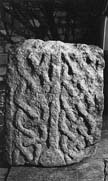Select a site alphabetically from the choices shown in the box below. Alternatively, browse sculptural examples using the Forward/Back buttons.
Chapters for this volume, along with copies of original in-text images, are available here.
Object type: Part of cross-shaft
Measurements: H. 55 cm (21.7 in) W. 45 > 41 cm (17.7 > 16.1 in) D. 19.5 > 19 cm (7.7 > 7.5 in)
Stone type: [Barnack Rag type, Upper Lincolnshire Limestone, Inferior Oolite Group]
Plate numbers in printed volume: Ills. 335–8
Corpus volume reference: Vol 5 p. 252
(There may be more views or larger images available for this item. Click on the thumbnail image to view.)
A section from the base of a tapered cross-shaft. The decoration is in low relief and is inaccurately and carelessly carved. The angles of the shaft have undecorated borders of rectangular section. The upper surfaces on all four faces are broken away, especially on face C.
A (broad): The face is divided into two vertical panels by a central shaft which expands at the bottom to form a rounded base. The two vertical fields are decorated with interlace, to the left a run of three-strand plait, to the right a run of four-strand plait.
B (narrow): Decorated with a run of four-strand plait.
C (broad): The face is divided by a central shaft with a rounded base, as on face A, although here the base is further elaborated by a subsidiary incised line. To either side of the shaft are two runs of four-strand plait, that to the left terminating with a pair of free ends, that to the right with two (poorly executed) asymmetrical loops. Much of the decoration on the upper parts of this face is rubbed away.
D (narrow): Decorated with a run of three-strand plait which is terminated towards the base with a pair of loops, one of which is fashioned from the free end.
Although the exaggerated thinness of this shaft, relative to its width, might suggest that it represents a rectangular grave-marker (as, for example, Harston, Leicestershire, seven miles north-west), rather than a taller cross-shaft, its proportions are within the range shown by members of the South Kesteven group (Chapter V): for instance it has similar proportions to Stoke Rochford (Ills. 346–9). It is certainly made of a similar stone type to other members of this group (unlike Harston) and the decoration at Stainby also associates it with this group; it employs the characteristic undecorated borders of rectangular section and long undifferentiated runs of plaitwork along the narrow faces. Within the South Kesteven group, Stainby has other affinities with Stoke Rochford, which also has a major panel divided by a central shaft into two vertical zones of interlace (Ill. 346). In the Stainby case, the central shafts have a rounded base which is reminiscent of rounded 'Calvary' bases on grave-covers (e.g. Lincoln Cathedral 1, Ill. 230), and this prompts the suggestion that there may have been a cross-bar higher up the shaft. The South Kesteven group of shafts are dated to the late tenth or eleventh centuries, but the carving at Stainby is of poor quality (compared with examples such as Creeton 1 or Colsterworth 1) and consequently it should be dated, like Stoke Rochford, late in the sequence, probably to the central part of the eleventh century.



